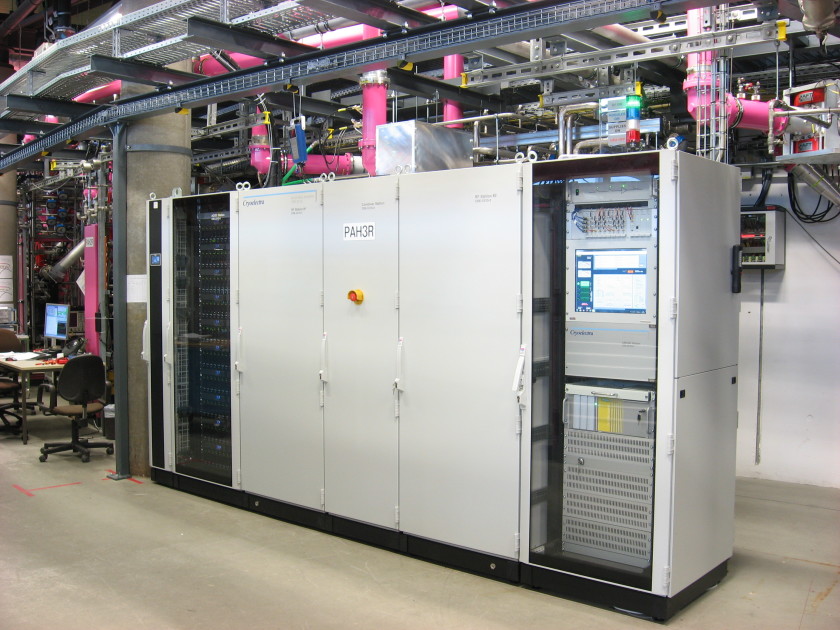BESSY II changes over to solid state RF amplifiers

One of the new solid state transmitters: the power supplies are located in the left rack (black), the RF section is located behind the grey doors in the middle and in the right rack the control units can be seen. © HZB
BESSY II storage ring has four cavity resonators that are excited with high-power oscillating electromagnetic fields to compensate for the energy lost by the electron beam. Four Klystrons, as they are called (large high-power linear RF vacuum tubes), have provided extremely pure 500-MHz RF power for exciting these cavity resonators up to now. But there are no replacement klystrons available on the market. Wolfgang Anders and his team at the HZB’s Institute SRF – Science and Technology have therefore used the shutdown to replace two of the klystrons with modern solid-state RF amplifiers. The other klystrons are to be replaced until the end of the year.
“This technology was first developed and employed at the SOLEIL synchrotron in France. However, SOLEIL operates with an excitation frequency of 350 MHz. By comparison, we work with a frequency of 500 MHz like most synchrotron light sources. We had to develop a new design for that reason. The development and manufacture of the RF amplifiers was carried out by a German company named Cryoelectra. We're the first photon source with this technology to have reached an excitation power of 75 kilowatts per amplifier for 500 MHz”, explains Anders.
While the vacuum-tube klystrons required a supply voltage of 26 kilovolts, the solid-state semiconductor RF amplifiers operate at just 50 Volts, but require much higher current. The energy saved is a big advantage. This is because klystron vacuum-tube RF amplifiers constantly draw full power from the mains, whereas the semiconductor RF amplifiers’ current draw is demand-follow and they only pull as much power from their mains connection as needed to compensate for the electron beam energy losses. In addition, the new RF units produce much less RF-noise, because the cavity resonators are excited more purely, which in turn improves the beam quality.
“My team has been working on implementing the new technology at BESSY II for three years. Just the extensive programming for connecting up to the control system interface and performing the signal processing for the solid-state amplifiers took a year for the engineer we hired specially for this. Now we have a very robust solution that is probably of interest to other synchrotron light sources as well”, says Anders.
arö
https://www.helmholtz-berlin.de/pubbin/news_seite?nid=14191;sprache=en
- Copy link
-
Battery research with the HZB X-ray microscope
New cathode materials are being developed to further increase the capacity of lithium batteries. Multilayer lithium-rich transition metal oxides (LRTMOs) offer particularly high energy density. However, their capacity decreases with each charging cycle due to structural and chemical changes. Using X-ray methods at BESSY II, teams from several Chinese research institutions have now investigated these changes for the first time with highest precision: at the unique X-ray microscope, they were able to observe morphological and structural developments on the nanometre scale and also clarify chemical changes.
-
BESSY II: New procedure for better thermoplastics
Bio-based thermoplastics are produced from renewable organic materials and can be recycled after use. Their resilience can be improved by blending bio-based thermoplastics with other thermoplastics. However, the interface between the materials in these blends sometimes requires enhancement to achieve optimal properties. A team from the Eindhoven University of Technology in the Netherlands has now investigated at BESSY II how a new process enables thermoplastic blends with a high interfacial strength to be made from two base materials: Images taken at the new nano station of the IRIS beamline showed that nanocrystalline layers form during the process, which increase material performance.
-
Hydrogen: Breakthrough in alkaline membrane electrolysers
A team from the Technical University of Berlin, HZB, IMTEK (University of Freiburg) and Siemens Energy has developed a highly efficient alkaline membrane electrolyser that approaches the performance of established PEM electrolysers. What makes this achievement remarkable is the use of inexpensive nickel compounds for the anode catalyst, replacing costly and rare iridium. At BESSY II, the team was able to elucidate the catalytic processes in detail using operando measurements, and a theory team (USA, Singapore) provided a consistent molecular description. In Freiburg, prototype cells were built using a new coating process and tested in operation. The results have been published in the prestigious journal Nature Catalysis.
